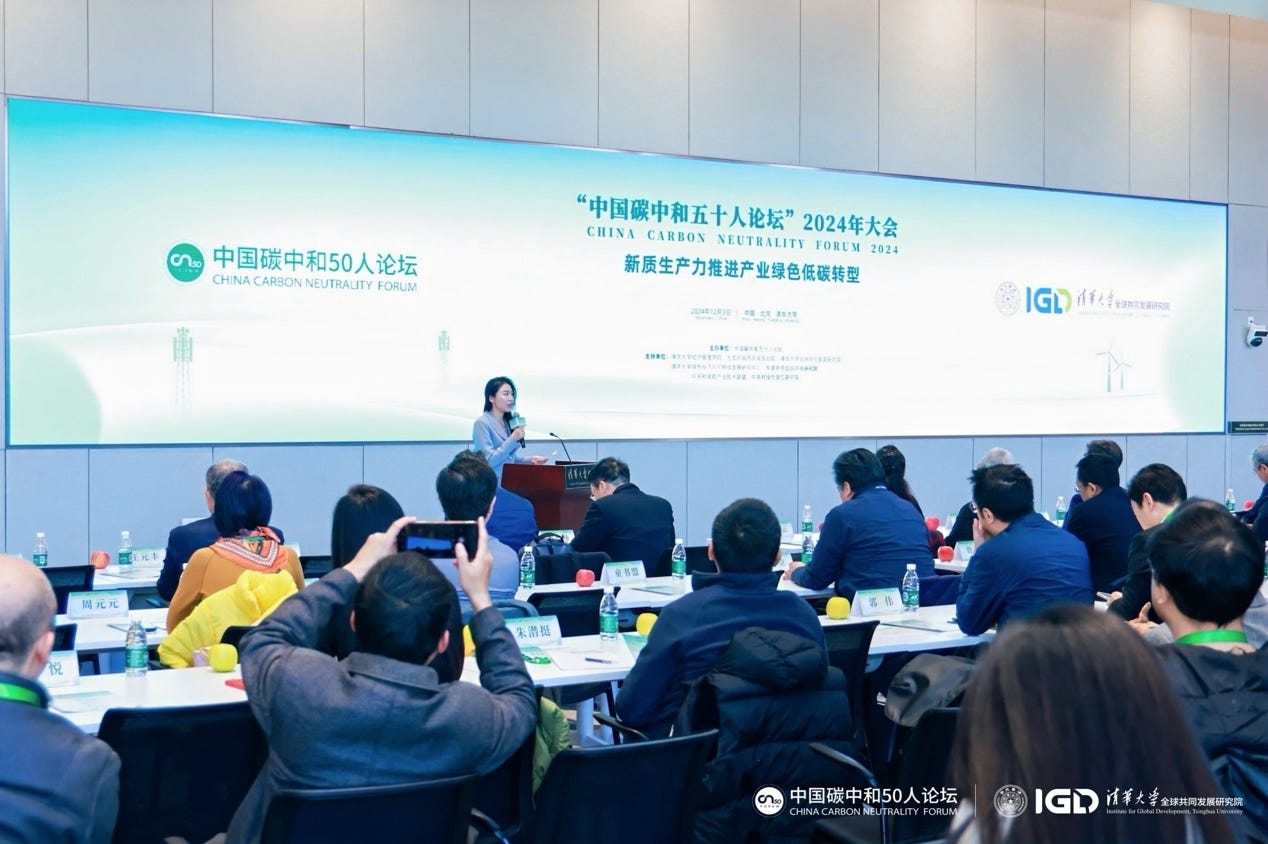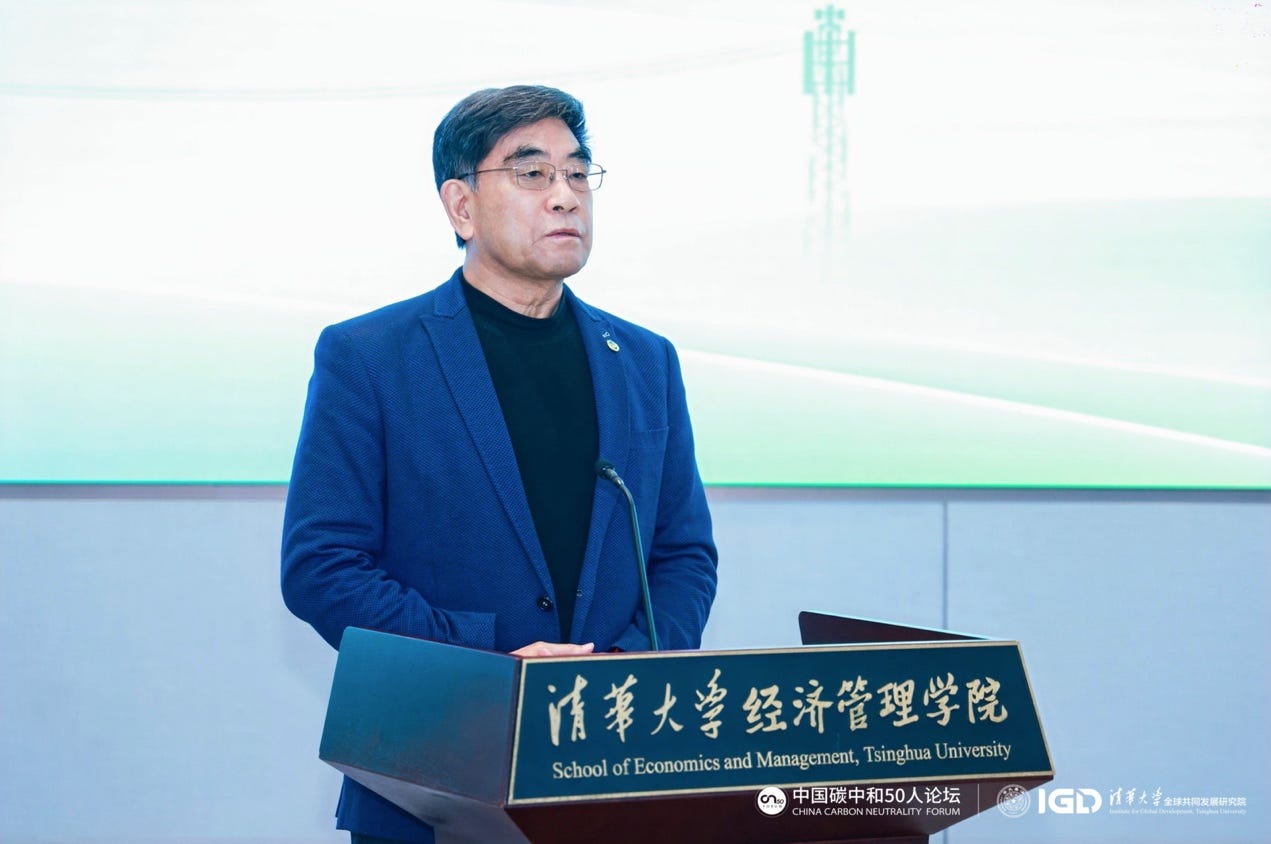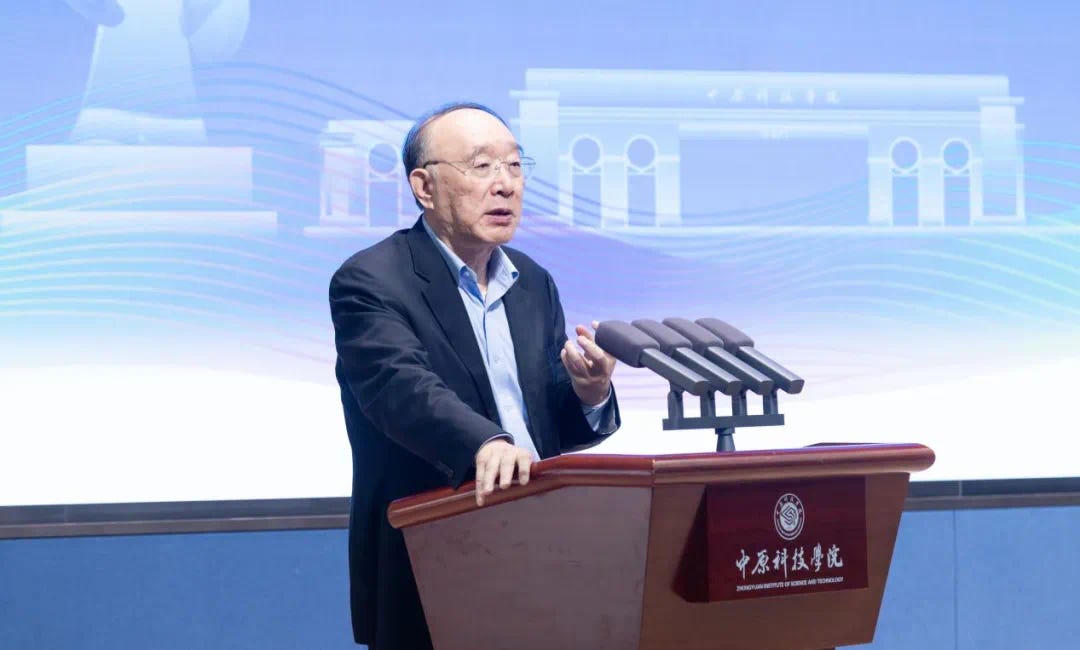China Climate Compass #4: Ex-Chairman of Sinopec on Green Transition and New Quality Productive Forces
Fu Chengyu, former chairman of Asia’s largest refiner, said new quality productive forces—centered on disruptive innovations such as CO2 utilization—will accelerate China’s green transition.
If you ask me what new quality productive forces are—or aren’t—I can’t give you a clear answer. Some concepts put forward by the Chinese government often seem vague, and this isn’t unusual. Such over-generalization of concepts in China has recently been spotlighted by Ziche Wang in his newsletter Pekingnology.
Typically, after these terms are introduced, they spark extensive discussions among officials, business leaders, scholars, and others. Perhaps the best way to make sense of them, including new quality productive forces, is to listen to how these different individuals interpret them and try to connect the dots.
So, let’s hear from one of China’s energy leaders on how he sees the connection between new quality productive forces and the low-carbon transition.
Today’s piece features a speech by Fu Chengyu 傅成玉 at the China Carbon Neutrality Forum 2024, organized by China Carbon Neutrality 50 Forum on December 3, 2024.
China Carbon Neutrality Forum, according to its official introduction, is a platform for academic exchange and industry and financial practices, jointly hosted by the Institute for Global Development of Tsinghua University, China Academy of New Supply-side Economics, Chinese Academy of Environmental Planning, and Beijing CSC Science & Technology Development Foundation. The forum is established to promote China’s comprehensive green transformation plan, achieve the strategic goal of “carbon peak, carbon neutrality” and build social consensus.
China Carbon Neutrality Forum 2024, themed “Driving Green and Low-Carbon Transition of Industries through New Quality Productive Forces” (“以新质生产力推动产业绿色低碳转型”) , offers an 8-hour live stream accessible here (in Chinese only).
About Mr. Fu Chengyu
Fu Chengyu, born in 1951, forged an extraordinary 40-year trajectory from manual laborer at Daqing Oilfield to chairman of China Sinopec, Asia's largest refiner. Born to impoverished farmers in Heilongjiang province, Fu began his early career in China's petroleum industry, which coincided with the nation's economic reforms. Through relentless self-education, Fu secured a pivotal 1984 government scholarship to study petroleum engineering at the University of Southern California, earning his master's degree in 1986.
His operational expertise propelled him to lead China National Offshore Oil Corporation (CNOOC) from 2003 to 2011, where he engineered a five-fold profit surge and $17.6 billion in strategic global acquisitions. This transformative leadership earned him Harvard Business Review's list of top 50 “best-performing CEOs in the world” in 2010. In 2011, he assumed chairmanship of Sinopec Group, steering China's energy modernization until his retirement.
Key Takeaways from Fu’s Speech
In his speech, Fu first summarized the institutional advantages and practical achievements of China's efforts in advancing its dual-carbon goals. He noted that China has built the world's most comprehensive green transition system through "top-level planning," featuring a broad legal framework, accelerating special legislation, supporting green finance, and improving the carbon trading market. This approach showcases solid action distinct from the slogan-driven emission reductions in Europe and the U.S.
He then focused on "new quality productive forces" and added that the core lies in reconstructing industrial chains through original innovation—breaking through disruptive technologies such as CO2 resource utilization to open new pathways for emissions reduction, while reorganizing production factors to enhance green productivity. He further highlighted the strategic opportunities brought by Industry 4.0, advocating for the transformation of western new energy bases into green industrial growth hubs, achieving a triple breakthrough in reducing grid burdens, regional balance, and source-level emissions through major projects in the west.
Fu then emphasized the need to activate the strategic value of the carbon market, calling for the establishment of a 24-hour spot and futures trading system, and incorporating the "Belt and Road Initiative" projects into a unified carbon market, making China's carbon pricing mechanism a global cost-sharing platform for green transformation.
Below is my translation of the speech.
用新质生产力更好实现碳达峰碳中和目标Leveraging New Quality Productive Forces to Better Achieve Carbon Peak and Carbon Neutrality Goals
Good morning to all the leaders, experts, and distinguished guests. It's a pleasure to join you at the "China Carbon Neutrality Forum 2024." I made a last-minute decision to attend, as I have a business trip this afternoon, and I really value this opportunity.
2024 marks a significant year for China in implementing the guiding principles from the 20th National Congress of the Communist Party of China (CPC), pushing for a comprehensive green transformation of its economy and society. The progress toward achieving the twin goals of carbon peak and carbon neutrality has been steady. We have seen the guiding principles from the 20th National Congress of the CPC put into practice. Additionally, the Third Plenary Session of the 20th Central Committee of the CPC outlined specific reform measures to promote harmony between humanity and nature. Following this, the Central Committee of CPC and the State Council issued guidelines to ramp up green transition in all areas of economic and social development, which will further speed up and solidify this transition.
In recent years, China has made rapid progress in renewable energy development, with significant strides in electric vehicles as well. The transition of traditional energy sectors and manufacturing industries to green and low-carbon models is also advancing steadily. Relevant laws on climate change and carbon neutrality are being developed, and progress is accelerating.
All of this demonstrates that China is making steady, serious, and effective progress towards a comprehensive green transformation and achieving the twin goals of carbon peak and carbon neutrality. In contrast, while many countries, particularly in Europe and North America, talk loudly about their goals, their actions differ significantly from China's.
China is unique in having a comprehensive national plan for a green transformation, backed by concrete execution strategies. It has clear long-term development goals, phased targets, a legal framework, and specialized laws in the works. Management systems and actionable guidelines, along with supportive policies and practical measures are all in place as well. Additionally, China is building a green financial system, supported by a carbon trading market.
Today, only China is driving green transition on a systematic, comprehensive scale, so, if China can't make it, no other country will. As Chinese, we must have greater confidence and determination, as we are on the path to realizing goals and leading the world through a unified top-down planning, which is the institutional strengths of our country.
The theme of today's forum is "Driving Green and Low-Carbon Transition of Industries through New Quality Productive Forces." Based on this theme, the title of my speech is: "Leveraging New Quality Productive Forces to Better Achieve Carbon Peak and Carbon Neutrality Goals." I welcome your feedback and suggestions.
First, it is essential to fully and faithfully understand the core of new quality productive forces. These forces encompass several key aspects: First, technological innovation serves as the primary driving force. Second, the emphasis is placed on industries and industrial chains. Third, green and low-carbon principles are the defining color. Fourth, the innovative combination of production factors is employed as a means.
What distinguishes the concept of technological innovation as the core driving force in new quality productive forces? The key difference lies in the shift in focus. New quality productive forces emphasize autonomous, original, disruptive, and cutting-edge innovations—essentially focusing on innovations that move from zero to one. The goal is to create new industries, business models, and sources of momentum through this type of innovation.
Focusing on industries and industrial chains means leveraging new quality productive forces to transform and upgrade traditional industries, grow emerging industries, and strategically develop future industries.
Having green and low-carbon as the defining color means strengthening green manufacturing, developing green services, and expanding the green energy sector.
The leverage of innovative production factors combinations means improving labor productivity through reform of production relations, which in turn promotes comprehensive green transformation.
It is crucial to understand that new quality productive forces emphasize technological innovation focused on creating new industries, business models, and sources of momentum—particularly through zero-to-one innovations. For example, to achieve carbon peak and carbon neutrality, we should prioritize original, disruptive, and cutting-edge innovations. Rather than simply reducing fossil fuel consumption, such as coal and oil, we should focus more on transforming carbon dioxide into a resource, with increased investment in technological innovation and R&D. Any success in this area could significantly reduce or even eliminate carbon emissions without cutting fossil fuel use, while also fostering new industries and business models.
The fourth industrial revolution is currently underway, characterized by digitalization and intelligence based on green, low-carbon, renewable energy. It is often said that intelligent terminals rely on electricity, and that electricity must be primarily sourced from green energy. The defining feature, broadest application, and most effective form of renewable energy is distributed consumption through local and microgrids.
In China, a notable aspect of renewable energy is that major energy bases are primarily concentrated in the western regions. This presents a significant challenge to the adaptability of the existing power grid and energy storage infrastructure. It also creates a new opportunity to rethink the layout and strategic planning of future industries, heavy industries, and manufacturing sectors.
One potential solution is to relocate large industrial and manufacturing projects to China’s renewable energy-rich western regions. This would enhance the region's capacity to absorb renewable energy, reduce the need for extensive investments in long-distance power grids, and minimize large-scale energy storage costs. Furthermore, it could address long-standing issues such as regional development imbalances, particularly the economic underdevelopment of the western regions. This strategy would also drive the green transition of China's industrial sectors and contribute to a more balanced economic structure and overall national development.
To achieve carbon peak and carbon neutrality goals in a quality way, China requires a market-driven, dynamic, and effective carbon trading market. By "market-driven," this means standardizing carbon certification, statistics, accounting, disclosure, and reporting, while also ensuring that the types of carbon credits and trading behaviors are market-oriented. A truly dynamic and effective carbon trading market must incorporate both spot and futures trading, operating continuously.
Such a vibrant carbon market would encourage companies to identify value, reduce development costs, and increase investment in green transformation through technology research and development and equipment manufacturing. This would create a positive feedback loop between the carbon trading market and innovation in technology and manufacturing. Ultimately, it would drive the growth of China’s green manufacturing industry, nurture the green services sector, and strengthen the green energy industry. This carbon trading market is not only a key platform for unleashing new quality productive forces but also a critical area for advancing them.
The Belt and Road Initiative is a significant strategic effort in China’s plan to build a community with a shared future for mankind. It must be green, low-carbon, and of high quality. Incorporating carbon reduction and carbon trading into Belt and Road projects within China’s unified carbon trading market is a natural step, and it is equally important to consider integrating carbon trading from neighboring countries. A dynamic carbon trading market based on market principles, governed by law and up to international standard can absorb or shift much of the substantial investments and costs involved in China’s green transformation and carbon goals. This will significantly accelerate the large-scale development of China’s green manufacturing and services sectors, becoming a powerful force in driving the high-quality, comprehensive green transition of China’s economy and society. Enditem
New-Quality Productive Forces: Insights from Ex-Chongqing Mayor Huang
Qifan Huang 黄奇帆, former mayor of southwest China’s Chongqing and now the Executive Deputy Directors of China Institute for Innovation & Development Strategy, delivered a speech titled “New Achievements and New Tasks in China's Reform, Opening-up, and Innovation under the New Paradign” on November 21, 2024, in Hefei of east China’s Anhui Province.
China Climate Compass #3: Climate Strategist on China’s Rise as Global Climate Leader
Climate denier Donald Trump's pledge to withdraw the U.S. from the Paris Agreement on his first day in office apparently signals that the world’s largest historical emitter may largely sideline itself from global climate action for years, again.






